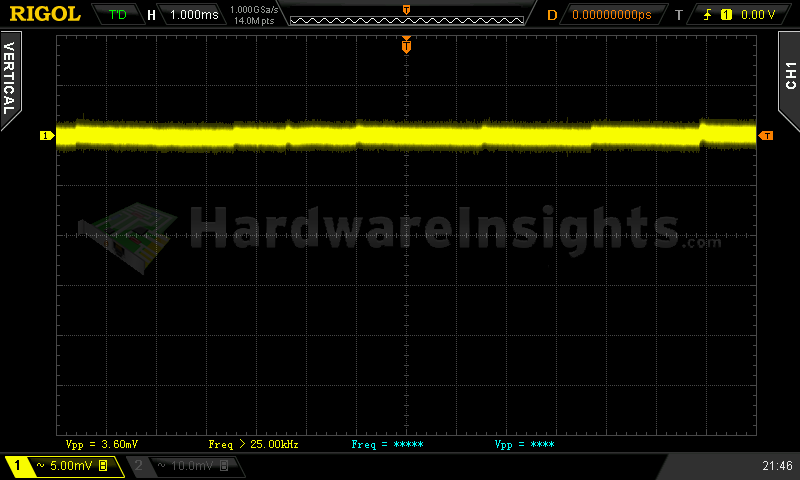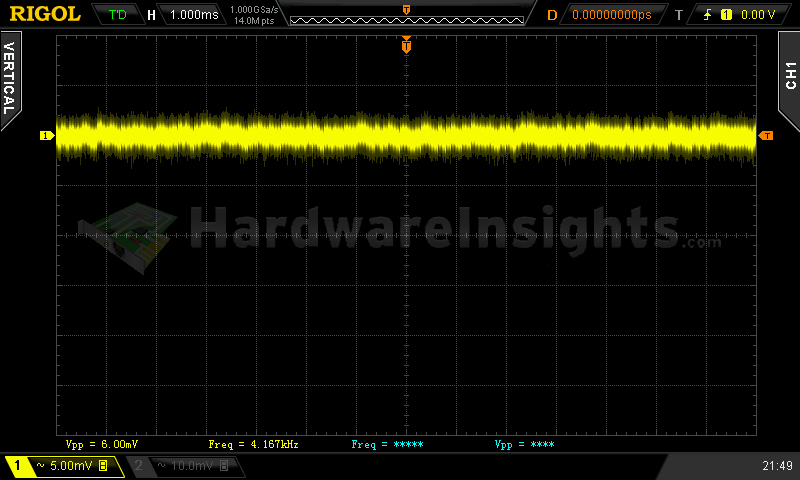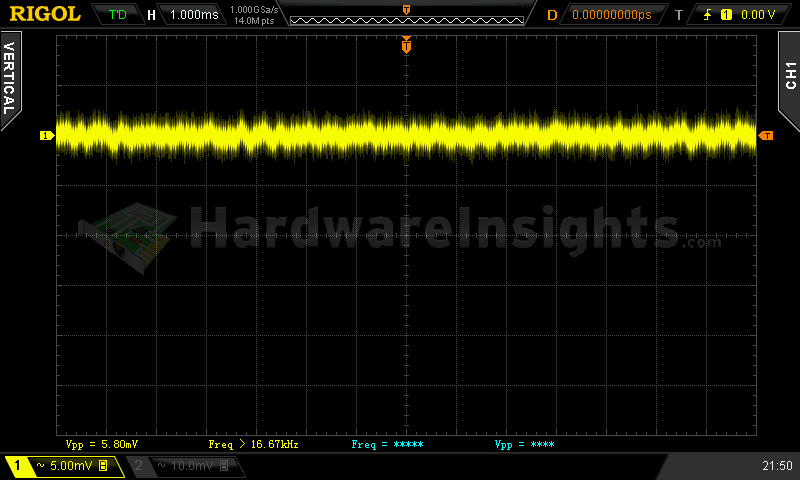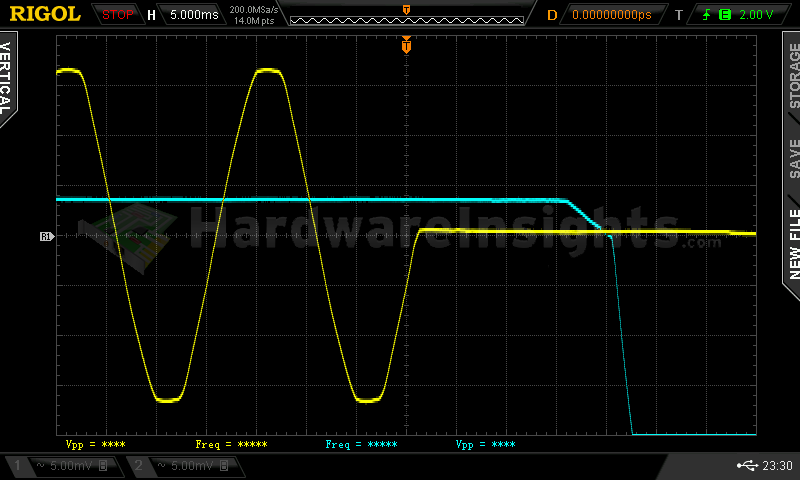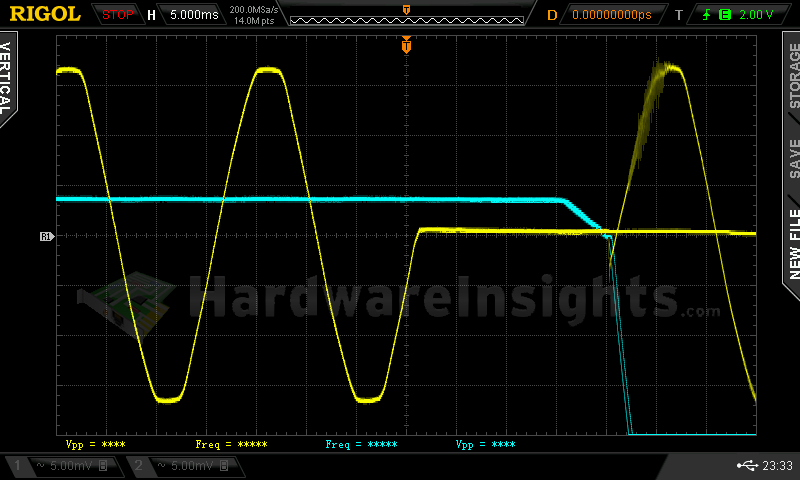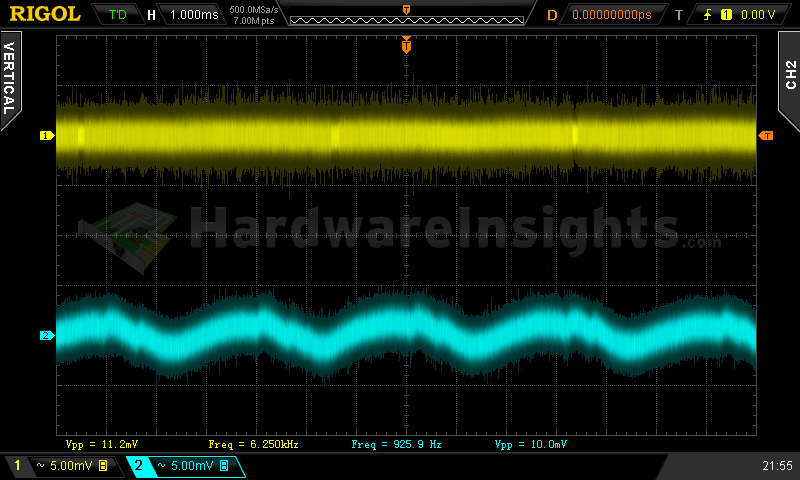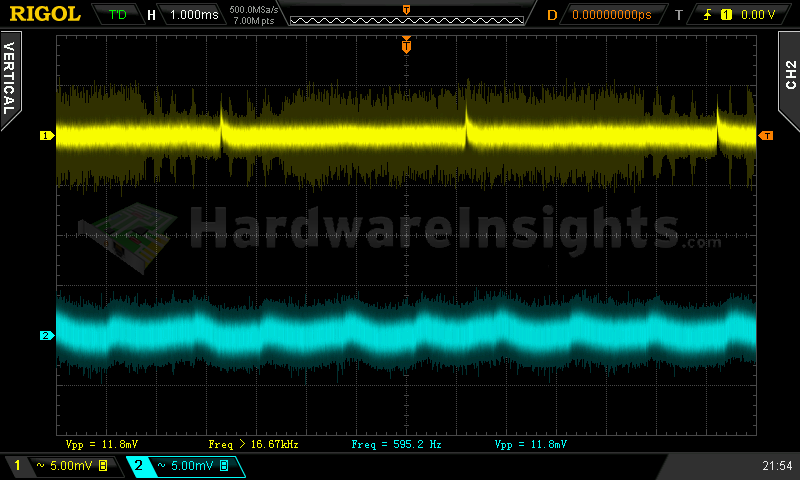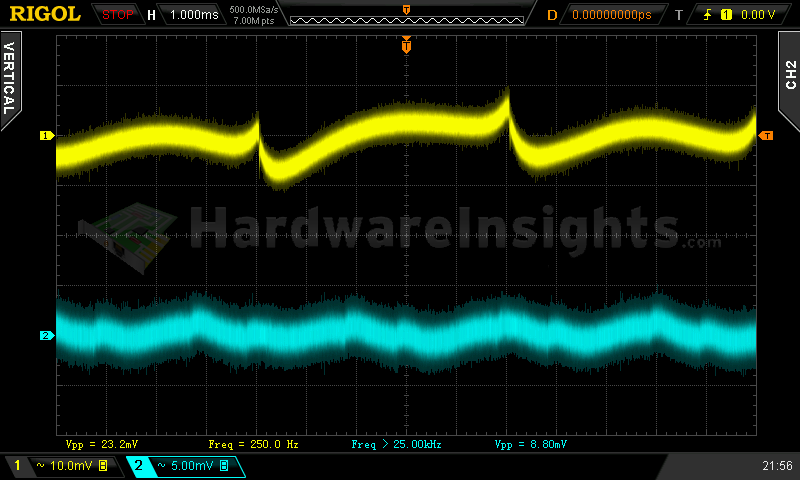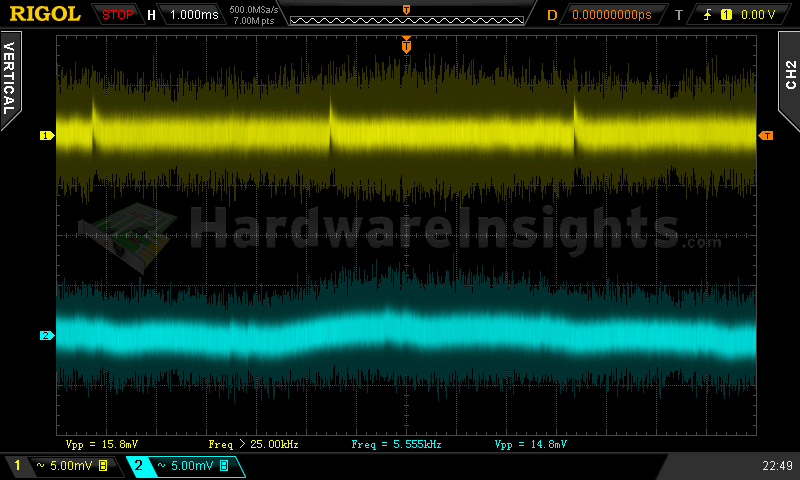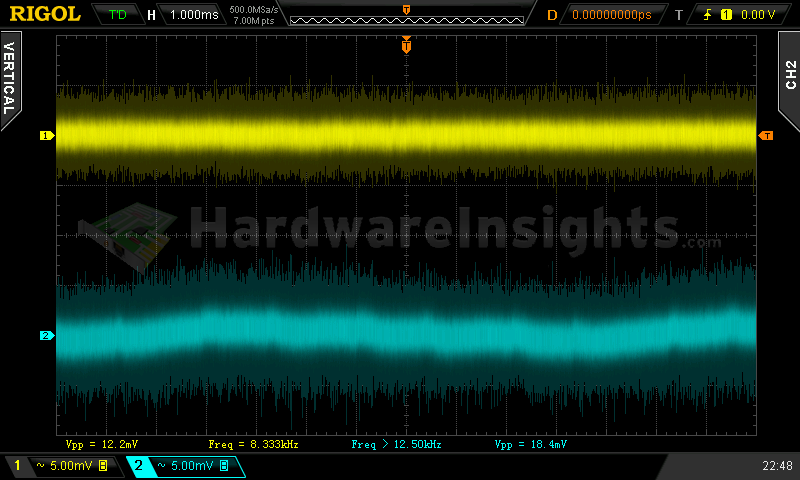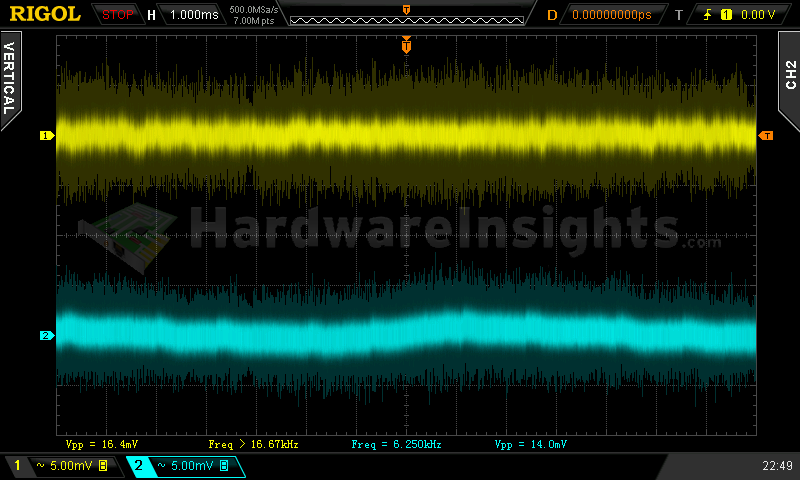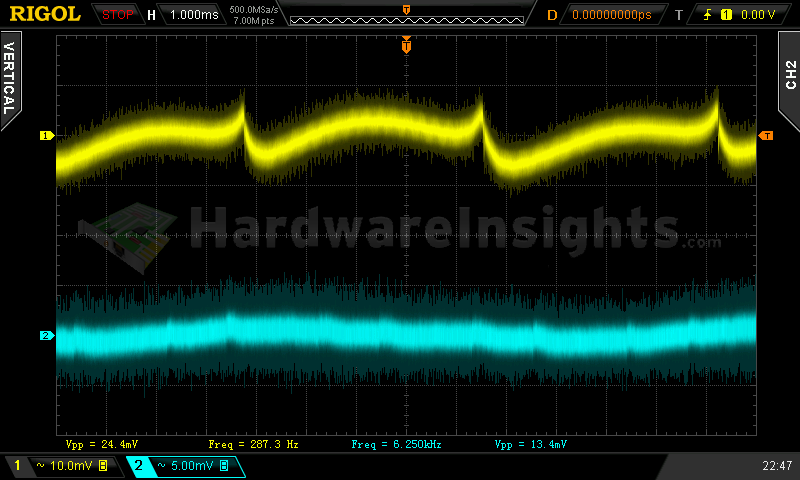Contents
- 1Introduction
- 1.1Packaging and accessories
- 2Connectors & cabling
- 2.1Casing & cooling
- 3Input filtering
- 4Primary side
- 4.1+5 V stand-by rail
- 5Secondary side
- 5.1Build quality
- 6Load testing
- 6.1Loading +5 V SB
- 6.2Voltage hold-up time
- 6.3Combined loading
- 6.4Combined loading ripple
- 6.5Crossloading, overloading
- 6.6Crossloading, overloading ripple
- 6.7Fan speed and temperatures
- 7Conclusion and evaluation
- 7.1Thanks
- 7.2Discussion
Load testing
Loading +5 V SB
As always, all load testing is done in accordance with our testing methodology. There has been just one small change. Now we’re using a different watt-meter, namely the Electrobock EMF-1. Besides it having a resolution of 0.1 W, I imagine that it is essentially the same as all the other inexpensive wall watt-meters. We see that the voltage regulation is not bad, it is tighter than 2%.
| Output (W) | Load (A) | Voltage (V)/ ripple (mV) | Input (W) | Efficiency/power factor |
| 0 | 0 | 5.09/3.60 | 0 | —/0 |
| 14.20 | 2.85 | 5.01/6.00 | 17.4 | 82.1 %/0.51 |
| 16.42 | 3.34 | 4.99/5.80 | 20.2 | 82.4 %/0.52 |
Ripple suppression is nice once again (it’s been a while, lately we’ve gotten mostly above 10 mV units) and the efficiency even crossed 82 % this time! It is at the same level or better than the Seasonic Platinum Fanless 520 W. So for these results I think it is only fair to also reward the Be Quiet! Dark Power Pro P11 550W three extra points.
+5 V SB ripple (left to right): 0 A; 2.85 A; 3.34 A
Voltage hold-up time
As we can see on the oscilloscope screenshot (unfortunately without cursors, after calibration I forgot to change the file format and kept only the waveforms), the hold-up time of the +12 V rail is OK, preciselly 19.4 ms. I would expect somewhat more though as the input capacitors have quite a high capacity. It seems that the switching section is not that effective in using their stored energy.
Trying to interrupt the power for 19.4 ms revealed that the hold-up time is slightly less, as can be seen on the image with the waveforms combined. It was 19.1 ms. This is still within specification but probably the lowest value so far.
Combined loading
Combined loading was very good. Firstly, let’s talk about the voltage regulation. All positive rails stood within ± 2 % regulation; and while the stand-by rail voltage started higher and dropped with load, the other rails were rock stable. There results are quite good, but still not as good as the last gold-awarded Corsair RM550x. Especially the results of the -12 V rail, which are just average, and although we only drew less than 0.4 A from this rail (specified current is 0.5 A), the voltage rose half a volt.
| Output power | Load/ voltage +5 V SB | Load/ voltage +3.3 V | Load/ voltage +5 V | Load/ voltage +12 V | Load/ voltage −12 V | Input power | Efficiency/power factor |
| 5.1 %/ 28.10 W | 0 A/ 5.08 V | 0 A/ 3.29 V | 0.382 A/ 5.01 V | 1.805 A/ 12.07 V | 0.384/ −11.46 V | 35.8 W | 78.5 %/ 0.80 |
| 20 %/ 111.98 W | 0.493 A/ 5.07 V | 1.46 A/ 3.29 V | 2.26 A/ 5.01 V | 7.64 A/ 12.08 V | 0.373/ −11.39 V | 127.8 W | 87.6 %/ 0.98 |
| 40 %/ 218.89 W | 0.98 A/ 5.06 V | 2.83 A/ 3.29 V | 3.42 A/ 5.01 V | 15.17 A/ 12.08 V | 0.371 A/ −11.47 V | 238.1 W | 91.9 %/ 0.99 |
| 60 %/ 327.45 W | 1.93 A/ 5.03 V | 4.43 A/ 3.28 V | 4.92 A/ 5.00 V | 22.7 A/ 12.08 V | 0.381 A/ −11.54 V | 356.1 W | 92.0 %/ 1 |
|
80 %/ 452.21 W |
2.39 A/ 5.02 V | 5.76 A/ 3.28 V | 6.07 A/ 5.00 V | 32.0 A/ 12.08 V | 0.382 A/ −11.65 V | 494.0 W | 91.5 %/ 1 |
| 100 %/ 555.31 W | 2.80 A/ 5.01 V | 8.24 A/ 3.28 V | 6.76 A/ 5.00 V | 39.4 A/ 12.08 V | 0.383 A/ −11.78 V | 612.0 W | 90.7 %/ 1 |
As for the efficiency, we reached 92%, so compared to other results from different websites, I think that this result has more to do with this wattmeter I currently have, which probably measures on the higher side of its accuracy. This unit is supposed to reach about a two percent higher peak efficiency of 94 % and so far it seems that it should be capable of that. This is also very nice.
Combined loading ripple
The ripple suppression of the Be Quiet! Dark Power Pro P11 550 W is exceptional, being slightly less than that of the Corsair RM550x. The -12 V rail did reach above 20 mV though, but overall it is still impressive. I did however notice something strange: when the unit was in stand-by, there was still a ripple of around 10 mV. It seems to me there is some interference coming through the unit from the power grid. It could also be that perhaps the stand-by supply was transfering some ripple to the other rails.
| Output % | Ripple +5 V SB | Ripple +3.3 V | Ripple +5 V | Ripple +12 V | Ripple −12 V |
| 5.1 | 9.6 mV | 11.8 mV | 11.8 mV | 11.8 mV | 23.2 mV |
| 20 | 13.2 mV | 13.8 mV | 13.8 mV | 12.6 mV | 24.4 mV |
| 40 | 13.2 mV | 15.2 mV | 15.2 mV | 15.8 mV | 23.6 mV |
| 60 | 14.2 mV | 14.2 mV | 14.2 mV | 17.2 mV | 26.0 mV |
| 80 | 15.8 mV | 15.2 mV | 15.2 mV | 18.8 mV | 26.0 mV |
| 100 | 16.4 mV | 12.2 mV | 15.8 mV | 18.4 mV | 24.4 mV |
Ripple 5.1% load (left to right): +5 V SB; +3.3 V; +5 V; −12 V . The second channel is connected to +12 V.
Ripple 100% load (left to right): +5 V SB; +3.3 V; +5 V; −12 V. The second channel is connected to +12 V.
Crossloading, overloading
Crossloading tests went very similar to the combined loading ones, and as this is a unit with DC-DC modules, I didn’t expect anything less. For that reason I even ran it with no load applied on certain rails and the unit handled that well. The stand-by voltage dropped a bit but otherwise it was still within 2%. With the +5V and +3.3V crossloading, the efficiency did not drop so much as with the other units, the P11 550 W managed to keep its efficiency at around 85%, so I’ll give one extra point for that.
| Output power | Load/ voltage +5 V SB | Load/ voltage +3.3 V | Load/ voltage +5 V | Load/ voltage +12 V | Load/ voltage −12 V | Input power | Efficiency/power factor |
| 20 %/ 107.27 W | 0.492 A/ 5.07 V | 23.5 A/ 3.28 V | 0.366 A/ 5.00 V | 1.791 A/ 12.08 V | 0.371 A/ −11.40 V | 127.3 W | 84.3 %/ 0.97 |
| 25 %/ 139.59 | 0.486 A/ 5.07 V | 0 A/ 3.29 V | 22.15 A/ 5.02 V | 1.805 A/ 12.08 V | 0.362 A/ −11.43 V | 160.7 W | 86.9 %/ 0.98 |
| 101 %/ 556.34 W | 0.488 A/ 5.07 V | 0 A/ 3.29 V | 0.393 A/ 5.01 V | 45.3 A/ 12.08 V | 0.396 A/ −11.79 V | 613.1 W | 90.7 %/ 1 |
| 122 %/ 673.73 W | 3.27 A/ 4.99 V | 4.13 A/ 3.29 V | 5.08 A/ 5.01 V | 50.8 A/ 12.08 V | 0.401 A/ −11.85 V | 748.2 W | 90.1 %/ 1 |
I did not reach the OCP limit on any rail, but the combined overload protection kicked in at slightly over 680 W. The unit worked fine while in the sweater for 15 minutes, and when I opened the sweater and measured the fan speed, it was still spinning at 1175 RPM, that is very close to the fan’s maximum rating. After stopping the fan, the unit turned itself off approximately just after a minute or so, but I believe it was already quite hot from being inside the sweater beforehand. Overall, it seems to run at quite a high internal temperature in order to keep the fan at the most minimum possible speed. Having said that, if I had kept it in the sweater longer even with the fan running, I think the unit would have eventually overheated as well.
Crossloading, overloading ripple
Mostly the same figures, I like this.
| Output % | Ripple +5 V SB | Ripple +3.3 V | Ripple +5 V | Ripple +12 V | Ripple −12 V |
| 20 | 12.8 mV | 9.8 mV | 12.4 mV | 15.2 mV | 21.6 mV |
| 25 | 12.8 mV | 12.8 mV | 13.8 mV | 18.0 mV | 20.4 mV |
| 101 | 12.6 mV | 8.6 mV | 15.0 mV | 18.8 mV | 20.8 mV |
| 122 | — | — | 15.0 mV | 16.2 mV | — |
Fan speed and temperatures
This unit’s fan started spinning right after turning the PSU on. During the first three tests, the speed was roughly 200 RPM, then it increased a bit. Still, I think I can comfortably state that it is virtually inaudible even under overload conditions.
| Output % | Fan speed (RPM) | Temperature intake/ outtake |
| 5.1 | 198 | 23 °C/ 24 °C |
| 20 | 200 | 23 °C/ 25 °C |
| 40 | 202 | 23 °C/ 26 °C |
| 60 | 272 | 23 °C/ 27 °C |
| 80 | 376 | 23 °C/ 27 °C |
| 100 | 493 | 23 °C/ 29 °C |
| CL 20 | 306 | 23 °C/ 28 °C |
| CL 25 | 267 | 23 °C/ 26°C |
| CL 101 | 209 | 23 °C/ 29 °C |
| OL 122 | 512 | 23 °C/ 32 °C |
The highest air temperature measured at the intput was 23 °C. Air near the outtake was over 32 °C, therefore I am concerned that running this unit at 100 % load in a very poorly ventilated case (with ambient temperatures over 30 °C) would ultimately result in it overheating. The fan’s default speed is too slow considering that the internal temperatures seem to be pretty high even when the fan is running at the maximum speed of 1200 RPM, so as I said, the unit may not be able to cool itself down under very harsh conditions.
